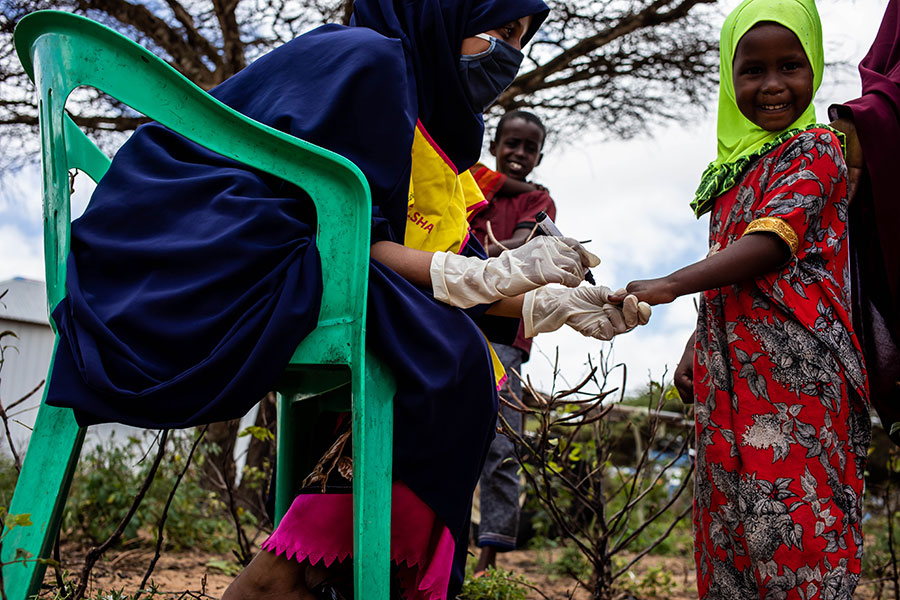 A child is vaccinated as part of national polio and measles vaccination campaign in Mogadishu, Somalia in September 2020. Ismail Taxta /WHO Somalia
A child is vaccinated as part of national polio and measles vaccination campaign in Mogadishu, Somalia in September 2020. Ismail Taxta /WHO Somalia
The world is close to polio eradication due to sustained immunization efforts with safe and effective vaccines. In the Eastern Mediterranean Region EMR, this involves vaccinating hundreds of millions of children annually using two main strategies: supplementary immunization activities (preventive and as outbreak response) and routine immunization.
The Eastern Meditteranean Region is the last WHO region worldwide considered endemic for wild poliovirus. It is also experiencing outbreaks of circulating vaccine-derived poliovirus, which occur when a population is not sufficiently protected against polio. Given this context, immunization efforts here are directed to reach the unreached children.
Supplementary immunization
Mass immunization campaigns, known as national immunization days (NIDs) or supplementary immunization activities (SIAs), are intended to complement routine immunization, which is the schedule of vaccinations a child follows from birth.
The aim of mass campaigns is to interrupt the circulation of poliovirus by immunizing every child under five years of age with oral polio vaccine, regardless of previous immunization status. This helps to catch children who have missed other immunization opportunities, and to boost immunity in those who have been immunized. This way, every child in the most susceptible age group is protected against polio at the same time, which reduces the ability for the poliovirus to infect any more children.
SIAs have been a vital tool for the polio programme, helping to reduce poliovirus transmission more than 99.99% globally since the global eradication effort began in 1988. In places where the virus is known or suspected to still be circulating or where SIAs have not reached enough children, the programme conducts ‘mop-up campaigns’ to raise overall population immunity.
For countries where shrinking GPEI resources have discontinued preventative SIAs, integrated multi-antigen campaigns present an opportunity to increase coverage and reduce the number of zero-dose children -- children who have received no dose of polio vaccine -- and children otherwise susceptible to polio.
Outbreak response campaigns
Outbreak response campaigns are launched in areas where the virus is newly detected, in an attempt to contain its spread. In a typical outbreak response, at least two high-quality rounds of vaccination is considered the baseline to provide adequate immunity to the population.
The recent emergence of circulating vaccine-derived polioviruses has called for outbreak response in several countries in the EMR. Regardless of the type of poliovirus outbreak, the response is the same: high-quality vaccination activities. These outbreak response campaigns work: in 2015 and 2018, respective outbreaks of wild poliovirus type 1 and circulating vaccine-derived poliovirus type 2 were successfully stopped in Syria, testimony to the incredible efforts of health workers to tackle the virus amidst conflict and large-scale population displacement. And in Somalia, a cVDPV3 outbreak that paralysed seven children was declared closed in early 2021.
Routine immunization
Polio eradication depends on all countries maintaining high routine immunization coverage of children, with polio vaccine included as part of national routine immunization schedules. Strengthening routine immunization is a core aspect of the GPEI’s 2022-2026 strategy.
While routine immunization alone cannot eradicate the disease, good routine polio vaccine coverage increases population immunity, reduces the incidence of polio and makes eradication feasible. If uniformly high immunization coverage is not maintained, pockets of unimmunized children build up, potentially leading to continued spread and outbreaks of poliovirus.
The polio programme advocates for polio-free countries to ensure high levels of immunization coverage to prevent the re-establishment of poliovirus through importations from other countries. This is a particular risk in the context of population movement across borders, or in places where particular communities are vaccine-hesitant or vaccine-averse and thus, more vulnerable to infection from vaccine-preventable diseases like polio.
Look up Routine Immunization Coverage, by country.
A strategic focus on targeting the most vulnerable children
Across much of the world, and particularly the EMR, immunization is the foundation of the primary healthcare system. It is a human right, and one of the best health investments money can buy. Immunization is also a critical service touchpoint between healthcare provider, parent and child -- for example, the polio programme, which often is the implementer of immunization activities in less developed EMR countries, is often the first to identify zero-dose children.
There are several connected, ongoing drives to ensure the most vulnerable children get the vaccinations they need, and the polio programme is integral to each:
The Immunization Agenda 2030: A Global Strategy to Leave No One Behind is a new global vision and strategy to address the challenges of reaching children with life-saving vaccines.
Gavi 5.0, is the new five-year plan offered by Gavi the Vaccine Alliance, and it includes specific funding to reach zero-dose children.




